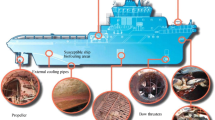Abstract
A critical problem in planning sampling paths for autonomous underwater vehicles (AUVs) is correctly balancing two issues. First, obtaining an accurate scalar field estimation and second, efficiently utilizing the stored energy capacity of the sampling vehicle. Adaptive sampling approaches can only provide solutions when real time and a priori environmental data is available. In this paper we present an analysis of adaptive sampling methodologies for AUVs. In particular, we analyze various sampling path strategies including systematic and stratified random patterns within a wide range of sampling densities and their impact in the energy consumption of the vehicle through a cost-evaluation function. Our study demonstrates that a systematic spiral sampling path strategy is optimal for high-variance scalar fields for all sampling densities and low-variance scalar fields when sampling is sparse. In addition, our results show that the random spiral sampling path strategy is found to be optimal for low-variance scalar fields when sampling is dense.










Similar content being viewed by others
References
Bennett, A. A., & Leonard, J. J. (2000). A behavior-based approach to adaptive feature detection and following with autonomous underwater vehicles. IEEE Journal of Oceanic Engineering, 25(2), 213–226.
Caldwell, C. V., Dunlap, D. D., & Collins, E. G. (2010). Motion planning for an autonomous underwater vehicle via sampling based model predictive control. In OCEANS 2010 (pp. 1–6), September 2010.
Chen, B., Pandey, P., & Pompili, D. (2012). An adaptive sampling solution using autonomous underwater vehicles. In IFAC Conference on Manoeuvring and Control of Marine Craft (MCMC), 2012, August 2012.
Chilès, J. P., & Delfiner, P. (2012). Geostatistics, modeling spatial uncertainty (2nd ed.). Hoboken, NJ: Wiley.
Cruz, N. A., & Matos, A. C. (2010). Adaptive sampling of thermoclines with autonomous underwater vehicles. In OCEANS 2010 (pp. 1–6), September 2010.
Delhomme, J. P. (1978). Kriging in the hydrosciences. Advances in Water Resources, 1, 251–266.
DeVore, R. A. (2007). Deterministic constructions of compressed sensing matrices. Journal of Complexity, 23(46), 918–925.
Donoho, D. L. (2006). Compressed sensing. IEEE Transactions on Information Theory, 52(4), 1289–1306.
Dunbabin, M., & Grinham, A. (2010). Experimental evaluation of an autonomous surface vehicle for water quality and greenhouse gas emission monitoring. In 2010 IEEE International Conference on Robotics and Automation (ICRA) (pp. 5268–5274).
Forrest, A. L., Bohm, H., Laval, B., Magnusson, E., Yeo, R., & Doble, M. J. (2007). Investigation of under-ice thermal structure: Small AUV deployment in Pavilion Lake, BC, Canada. In OCEANS 2007 (Vol. 1, pp. 1–9).
German, C. R., Yoerger, D. R., Jakuba, M., Shank, T. M., Langmuir, C. H., & Nakamura, K. (2008). Hydrothermal exploration with the autonomous benthic explorer. Deep Sea Research Part I: Oceanographic Research Papers, 55(2), 203–219.
Haeger, S. D. (1995). Vertical representation of ocean temperature profiles with a gradient feature model. In OCEANS’95. MTS/IEEE. Challenges of Our Changing Global Environment. Conference Proceedings (Vol. 1, pp. 579–585), October 1995.
Kumagai, M., Ura, T., Kuroda, Y., & Walker, R. (2000). New AUV designed for lake environment monitoring. In Proceedings of the 2000 International Symposium on Underwater Technology, 2000. UT 00 (pp. 78–83).
McBratney, A. B., Webster, R., & Burgess, T. M. (1981). The design of optimal sampling schemes for local estimation and mapping of regionalized variables I: Theory and method. Computers and Geosciences, 7, 331–334.
Ocean Server Technology Inc. (2012). Iver2, auv@online. Retrieved December, 2012 from http://www.oceanserver-store.com/iver2auv.html.
Popa, D. O., Sanderson, A. C., Komerska, R. J., Mupparapu, S. S., Blidberg, D. R., & Chappel, S. G. (2004). Adaptive sampling algorithms for multiple autonomous underwater vehicles. In Autonomous Underwater Vehicles, 2004 IEEE/OES (pp. 108–118), June 2004.
Smith, R. N., Chao, Y., Li, P. P., Caron, D. A., Jones, B. H., & Sukhatme, G. S. (2010). Planning and implementing trajectories for autonomous underwater vehicles to track evolving ocean processes based on predictions from a regional ocean model. International Journal of Robotics Research, 29, 1475–1497.
Stoker, C. R., Barch, D., Farmer, J., Flagg, M., Healy, T., Tengdin, T., Thomas, H., Schwer, K., & Stakes, D. (1996). Exploration of Mono Lake with an ROV: A prototype experiment for the maps AUV program. In Proceedings of the 1996 Symposium on Autonomous Underwater Vehicle Technology (pp. 33–40), June 1996.
van Overschee, P., & De Moor, B. (1996). Subspace identification of linear systems: Theory, implementation, applications. Dordrecht: Kluwer Academic Publishers.
Witt, J., & Dunbabin, M. (2008). Go with the flow: Optimal AUV path planning in coastal environments. In Australian Conference on Robotics and Automation, 2008.
Zhang, B., & Sukhatme, G. S. (2007). Adaptive sampling for estimating a scalar field using a robotic boat and a sensor network. In 2007 IEEE International Conference on Robotics and Automation (pp. 3673–3680), April 2007.
Author information
Authors and Affiliations
Corresponding author
Rights and permissions
About this article
Cite this article
Mora, A., Ho, C. & Saripalli, S. Analysis of adaptive sampling techniques for underwater vehicles. Auton Robot 35, 111–122 (2013). https://doi.org/10.1007/s10514-013-9337-0
Received:
Accepted:
Published:
Issue Date:
DOI: https://doi.org/10.1007/s10514-013-9337-0




